However La Ideal spent almost all of its life since it was built in 1912 as a pastry shop and salon de te´, and it wasn't until the 1990s that tango dancing became its raison d'etre. The original owners were pastry chefs and entrepreneurs from Spain, who required that the building be constructed of expensive materials from all over Europe.
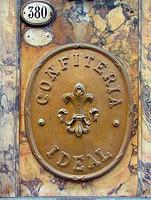 The French Fleur de Lys became the enigmatic emblem because at that time all of the expensive buildings in Buenos Aires were influenced by French architectural design, albeit La Belle Epoque of a few decades past. For that reason the premises seem much older than a scant century, and also because it is now derelict and decrepit. The gorgeous cage elevator hasn't worked in decades, and the iconic stained glass pastry quiosco glorieta empty but for the occasional tango shoe display.
The French Fleur de Lys became the enigmatic emblem because at that time all of the expensive buildings in Buenos Aires were influenced by French architectural design, albeit La Belle Epoque of a few decades past. For that reason the premises seem much older than a scant century, and also because it is now derelict and decrepit. The gorgeous cage elevator hasn't worked in decades, and the iconic stained glass pastry quiosco glorieta empty but for the occasional tango shoe display.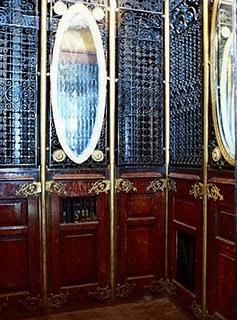
The gorgeous elevator that hasn't moved in decades
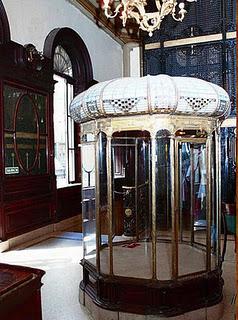
Emblematic empty display case
I will never forget walking up its marble staircase for the first time, smelling the mustiness, the cat piss, the burning incense lit to hide the odors of a building past its prime. I was a beginning tanguera in a culture that had seen very few tango tourists up to then. The milonga habitués looked upon our tour group from America as exotic creatures from another world, as I suppose we were. That's how we viewed the salon and the dancers of La Ideal.
All of this adds to its faded glamor.
Through the decades it was the place to meet your friends for afternoon tea, particularly after work. It became de riguer for the bourgoisie of Buenos Aires (especially the English) to meet there and have their private parties on Saturdays.
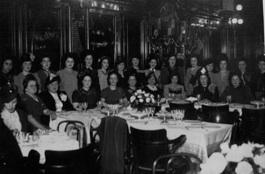
The upstairs ballroom was used for special occasions; the ground floor for tea, coffee, and the delicious pastries La Ideal was famous for, as well as live music. It's said that the miga sandwich was invented there as a copy of English finger sandwiches.
Between 1979 and 1981 it was converted into a café-concert with all types of live music, including a famous all-girl orchestra and The Five Latins. The salon has been visited over the years by many celebrities, such as Maurice Chevalier, Charles Aznavour, Mirta Legrand and Daniel Tinayre, Jorge Luis Borges, Ernesto Sábato, Yoko Ono, Sting, Charly García, Diego Maradona, Julio Bocca,Moria Casán, Willem Dafoe, Robert Duvall, María Félix, Dolores del Río, Vittorio Gassman..
R
It also has been used as a location for all of the tango movies, so first-time visitors feel a déja-vu, of having dreamed this place. As indeed it is the stuff of dreams--many scenes in my memoir, The Church of Tango, take place in La Ideal.
Lots of rumors surround La Ideal, and no one seems to actually know who owns it--some say the government--but the truth is that it is owned by a private organization that receives no government help to maintain this historic structure. (It is managed by Jorge Vieites Rouco.) Unfortunately, it is falling apart before our eyes, even though it is now proclaimed an official Bar Notable. I wouldn't be surprised if one day a foreigner steps in to save it--in the manner of Versailles in France. Sometimes foreigners value a place's heritage more than the locals.
Several years ago the gigantic central chandelier below the skylight on the first floor, worthy of the Phantom of the Opera, crashed to the floor, and I presume never to be seen again.

My photo from '97: see the huge chandelier? Now gone.
And on Oct 12, 2008--the ceiling falls:
Once upon a time there was the Gran Ciné Ideal (recently a porno theater) next door which insured that the confiteria was even more heavily used before and after film showings.
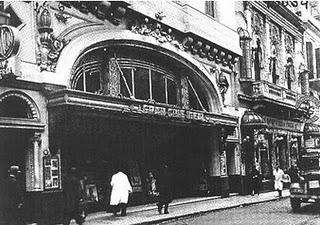
La Confiteria is at the right of the theater.
And a story which I find fascinating: originally the ceiling of the ground floor was open in an oval shape matching the skylight, and upstairs was a gallery around this opening for people to look down, and for light and the skylight to be seen from below. Years later the stone dance floor was laid down.
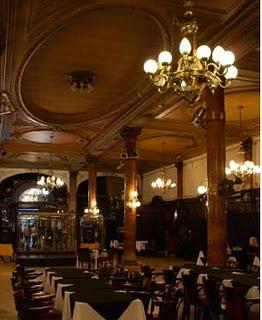
Here you can see the oval on the ceiling of the ground floor that used to be open
A visiting tourist might not actually know what tango is, but feels certain that the tango was born at La Ideal, although tango didn't arrive there until the middle of the 1990s, just shortly before I visited for the first time in 1997. I too thought I saw the ghosts of tangueros of dusty years past in the mirrors lining the walls. The building itself has a haunting presence and a life of its own. May it live forever.
The BBC Documentary
Read more: La Confiteria Ideal
